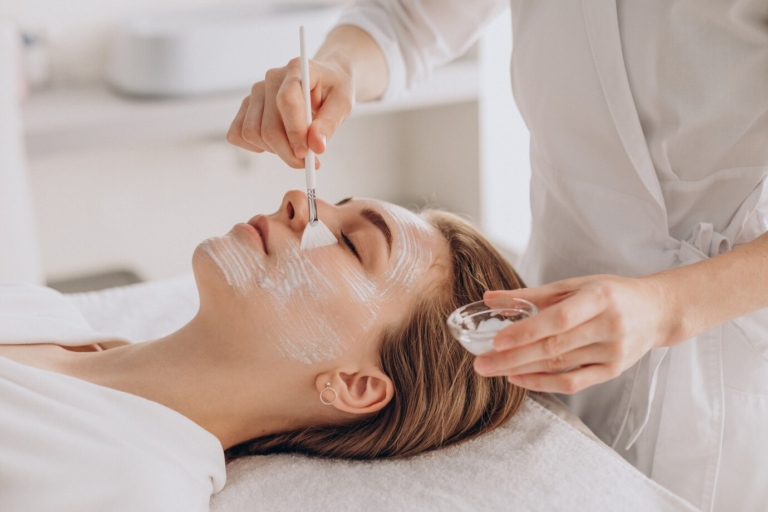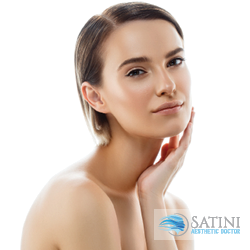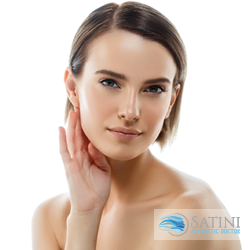Renew your skin with a chemical peel- affordable, as good, effective
Chemical peels are a popular cosmetic treatment designed to improve the appearance and texture of the skin. By applying a chemical solution to the skin, the treatment exfoliates the outer layers, prompting the skin to regenerate and revealing a smoother, more even-toned complexion. Chemical peels can address various skin concerns, including fine lines and wrinkles, sun damage, hyperpigmentation, acne, and scars.
| Mild Chemical Peel | Moderate Peel | Deep Peel | |
|---|---|---|---|
| Type of Peel | ASAP Peel | Jessner Peel
Mesoestetic Melano Plus Peel |
Cosmelan Mask
Phenol Peel High Concentration PCA Peel |
| Benefits | Mild signs of ageing
Restores radiance and a healthy glow Ultra relaxing Facial |
Moderate signs of ageing
Dark spots |
Deep rejuvenation of the skin |
| Advantages | Affordable
Simple Effective |
Better results
Affordable |
Superior results
Affordable |
| Disadvantages | Not many | Some downtime
Peeling, redness, swelling |
Significant downtime
Risk of scarring and infection TCA peel can be toxic to the heart |
| Downtime | None | Little | 2 to 3 days, up to a week |
| Discomfort | Very mild | Mild to moderate | Moderate to severe |
Commonly Asked Questions About Chemical Peels
What is a chemical peel?
A chemical peel is a beauty treatment that uses acid to remove the top layer of skin. This helps to achieve a smoother complexion, promotes skin regeneration, and improves its texture, tone, and appearance.
Chemical peels can vary in depth and intensity, from targeting the top layer of skin to reaching deeper layers. Doctors commonly use chemical peels to address fine lines, wrinkles, sun damage, acne scars, and uneven skin pigmentation.
A chemical peel is a simple and effective treatment that lasts 30 minutes. We will cleanse your skin thoroughly before the treatment.
After this, we will perform a skin check to ensure you are a suitable candidate for the procedure. Following that, we will apply the solution and leave it on your face for a few minutes. Finally, after a few minutes, we apply a neutralizing solution to remove the peel.
We will treat you to a luxurious face mask from our high-end DP range. This mask, supported by science, contains nourishing ingredients for your skin. It will provide you with a relaxing and memorable experience.
Mild (Superficial) Peels
Purpose
- Treat minor skin imperfections like fine lines, mild sun damage, uneven skin tone, and acne.
Chemicals Used:
- Alpha-hydroxy acids (AHAs) like glycolic acid, lactic acid, or fruit enzymes.
- Beta-hydroxy acids (BHAs) like salicylic acid.
Procedure:
- The doctor puts a chemical solution on the skin for 10-15 minutes and then washes it off.
Recovery Time:
- There is little to no downtime; slight redness and flaking may occur but typically resolve within a few days.
Effects:
- Mild improvement in skin texture and tone.
- You can repeat this every few weeks for optimal results.
Risks:
- There is minimal risk of complications, making it suitable for all skin types.
Moderate (Medium) Peels
Purpose:
- Address more pronounced skin issues such as deeper wrinkles, moderate sun damage, age spots, and superficial scars.
Chemicals Used:
- Mesoestetic Melanopeel
- Jessner’s solution (a mix of lactic acid, salicylic acid, and resorcinol).
Procedure:
- You put the chemical solution on the skin for 15-30 minutes and it may cause a burning or stinging feeling.
Recovery Time:
- Requires more downtime than mild peels; redness, swelling, and peeling typically last about a week.
- You will see full recovery and results within two weeks.
Effects:
- Noticeable improvement in skin texture, tone, and pigmentation.
- You can repeat it every few months as needed.
Risks:
- Potential for hyperpigmentation or hypopigmentation, particularly in darker skin tones.
- There is a higher risk of infection and scarring compared to mild peels.
Deep Peels
Purpose:
- Treat severe skin imperfections such as deep wrinkles, significant sun damage, deep scars, and precancerous growths.
Chemicals Used:
- Phenol or high-concentration TCA.
Procedure:
- The doctor applies the chemical solution for a long time. Because the treatment is intense, patients may require sedation or anesthesia.
- The procedure may take up to 90 minutes, and you need to have an oxygen and heart rate monitor to prevent complications.
Recovery Time:
- Significant downtime; the skin will be red, swollen, and oozing for the first few weeks.
- It can take several months to heal completely, and you must avoid sun exposure.
Effects:
- Dramatic improvement in skin appearance and texture.
- One treatment is often enough to achieve long-lasting results.
Risks:
- There is a high risk of complications, including infection, scarring, and changes in skin pigmentation.
- Dermatologists do not recommend it for darker skin tones because of the high risk of pigmentation problems.
What acids do you use in a peel?
Chemical peels can be formulated with various acids, each targeting specific skin concerns. Some common acids used in chemical peels include:
- Alpha Hydroxy Acids (AHAs):
- Glycolic acid (derived from sugar cane)
- Lactic acid (derived from sour milk or fermented fruits)
- Citric acid (derived from citrus fruits)
- Mandelic acid (derived from almonds)
- Beta Hydroxy Acids (BHAs):
- Salicylic acid (commonly used for acne treatment)
- Trichloroacetic Acid (TCA):
- In chemical peels, TCA treats sun damage, fine lines, and pigment issues.
- Jessner’s Solution:
- A combination of salicylic acid, lactic acid, and resorcinol, often used in medium-depth peels.
- Phenol:
- Phenol is used in deep chemical peels and is highly effective for treating severe sun damage, deep wrinkles, and scars. However, complications often occur.
Chemical peels, despite their misleading name, mostly contain natural acids. We use the ASAP peel range, which contains only natural ingredients. For example, skincare professionals commonly use lactic acid in ASAP peels. This acid comes from sour milk, and people use it as a very mild peel for the skin.
Glycolic acid is another acid found in sugar cane and sugar beet.
Chemical peels can effectively address a variety of skin problems and concerns. The specific type and depth of the peel determine the extent of improvement. Here are common skin problems that chemical peels can treat:
Fine Lines and Wrinkles:
Chemical peels can reduce fine lines and wrinkles on the skin.
Sun Damage
Peels effectively treat sun-damaged skin, including sunspots, pigmentation irregularities, and freckles.
Acne and Acne Scars
Chemical peels with salicylic acid can help treat acne and reduce acne scars. The chemical helps to unclog pores, reduce inflammation, and diminish acne scars.
Uneven Skin Tone and Texture
Peels help improve skin texture by promoting exfoliation and cell turnover, resulting in a smoother and more even complexion.
Hyperpigmentation:
Chemical peels can lighten and reduce the appearance of hyperpigmentation, including melasma, age spots, and dark patches.
Enlarged Pores
Peels can help minimize the appearance of enlarged pores by exfoliating the top layer of skin.
Rosacea and Redness
Some chemical peels can reduce redness from conditions like rosacea by having anti-inflammatory properties.
The amount of downtime required after a chemical peel depends on the type and depth of the peel performed. Here’s a general guideline:
- Superficial Peels (Light Peels):
- These typically use mild acids like alpha hydroxy acids (AHAs) and have minimal downtime.
- There might be some redness and mild peeling, but you can usually resume normal activities immediately.
- Medium Peels:
- Medium-depth peels, often using trichloroacetic acid (TCA), may involve more noticeable peeling and redness.
- Downtime is usually a few days, during which you may experience swelling and peeling.
- Deep Peels:
- Using phenol or high concentrations of TCA, deep peels can result in more significant peeling and redness.
- Downtime can be a week or longer, and you may need to limit sun exposure during the recovery period.
Fair Skin
- Suitability: Fair skin is generally very suitable for chemical peels, as it is less likely to develop post-inflammatory hyperpigmentation (PIH).
- Types of Peels: Most superficial, medium, and deep peels, can be safely used.
Medium to Olive Skin
- Suitability: Chemical peels can be effective but require careful selection to minimize the risk of hyperpigmentation.
- Types of Peels: Superficial peels with glycolic acid, salicylic acid, or lactic acid are usually safer options. Medium peels can be used with caution.
Dark Skin
- Suitability: Suitable for chemical peels but with a higher risk of PIH (post-inflammatory hyperpigmentation) and keloid scarring.
- Types of Peels: Superficial peels are generally preferred. Ingredients like lactic acid and mandelic acid are less likely to cause pigmentation issues. Medium peels can be used but require careful monitoring.
Sensitive Skin
- Suitability: Suitable for chemical peels, but gentle acids and lower concentrations should be used to avoid irritation.
- Types of Peels: Lactic acid peels are a good option, as they are milder and hydrating. Patch testing is recommended before a full treatment.
Acne-Prone Skin
- Suitability: Highly suitable for chemical peels, as they can help clear acne and reduce acne scars.
- Types of Peels: Salicylic acid peels are particularly effective for acne-prone skin due to their ability to penetrate and unclog pores. Glycolic acid peels can also be beneficial.
Mature Skin
- Suitability: Chemical peels can effectively reduce fine lines, wrinkles, and age spots.
- Types of Peels: Medium to deep peels can provide significant anti-aging benefits. However, these peels require more downtime and post-treatment care.
The duration of a chemical peel can vary based on the type and depth of the peel. Superficial peels may take around 30 minutes, while deeper peels may take longer. We also like to allow more time for more complex peels. This is so we can provide you with detailed aftercare instructions and answer all your questions.
When people receive treatment, they often feel a tingling sensation. This feeling usually disappears after a few minutes. After the treatment, we put on a calming face mask that helps with tingling and cools the skin.
Remember that your face may feel warm or slightly sunburnt for a few hours after the peel. Therefore, some prefer to sleep with their heads elevated at 45 degrees the night after the treatment. This can help to reduce mild swelling and discomfort.
We also recommend you avoid sun exposure for a few days after the procedure. Please always apply SPF 50+ sunscreen.
We will carefully assess your skin and provide a detailed treatment plan. Most people require 3 to 6 treatments every fortnight to achieve the best results. Please make an appointment to discuss your individual needs.
Depending on your needs and goals, chemical peels can be combined with other cosmetic procedures. It is often necessary to wait at least a few days after a chemical peel before you can have another procedure.
This is because a chemical peel causes inflammation of the skin. This can affect how well other treatments work.
Chemical peels are exceptionally safe in the hands of a qualified medical professional. Very rarely, allergic reactions can occur.
Deeper peels may slightly increase the risk of post-inflammatory hyperpigmentation, especially in individuals with darker skin tones. Due to that risk, we offer peels that contain anti-pigmentation ingredients.
We will assess your skin type carefully before peeling to prevent any complications.
After a chemical peel, following proper aftercare instructions is crucial to ensure optimal results and minimize the risk of complications. Here are some general aftercare instructions:
- Sun Protection:
- Use a broad-spectrum sunscreen with at least SPF 30 or higher.
- Avoid direct sun exposure, and wear protective clothing, hats, and sunglasses.
- Avoid Irritating Products:
- Refrain from using products containing retinoids, benzoyl peroxide, and other potentially irritating ingredients for a few days or as advised.
- Gentle Cleansing:
- Use a mild, non-abrasive cleanser to wash your face.
- Avoid harsh scrubbing, and pat your skin dry instead of rubbing.
- Hydration:
- Moisturize your skin regularly to help maintain hydration.
- Choose a gentle, hypoallergenic moisturizer without harsh chemicals.
- Avoid Picking or Peeling:
- Do not pick at peeling skin, as this can lead to scarring and complications.
- Let the skin naturally slough off.
- Cool Compresses:
- If you experience swelling or discomfort, you can apply cool compresses to the treated area.
- Limit Physical Activity:
- Avoid strenuous exercise and activities that may cause excessive sweating for a few days post-peel.
- Follow Post-Peel Care Products:
- If your skincare professional recommends specific post-peel products, use them according to the provided instructions.
- Stay Hydrated:
- Drink plenty of water to support overall skin health.
- Avoid Saunas and Hot Baths:
- Steer clear of saunas, hot baths, and other activities that may cause excessive heat to the treated area.
- Follow-Up Appointments:
- Attend any scheduled follow-up appointments to assess your skin’s response to the peel.
- Be Patient:
- Allow your skin time to heal, and avoid expecting immediate results.
- Follow the recommended timeline for subsequent peels or maintenance treatments.
Always consult your skincare professional for personalized aftercare instructions based on the peel you’ve undergone and your individual skin needs. Contact us promptly if you experience any side effects.
You can get a chemical peel in the summer, but remember to protect your skin and follow these tips for the best results:
Sun Exposure
After a chemical peel, your skin will be more sensitive to the sun. You can still safely have a chemical peel if you wear SPF 50+ sunscreen and additional protection, such as a sun hat. If you have a deeper peel, you may stay indoors for one or two days.
Timing
Plan the timing of your chemical peel wisely. Avoid scheduling it before a beach vacation or extended outdoor activities with much sun exposure.
Type of Peel
Consider the type of chemical peel you are getting. Superficial peels are a good choice for summer. They have minimal downtime and cause less skin sensitivity. In contrast, deeper peels have more downtime and can be harsher on the skin.
Prices vary depending on what type of peel you require. Prices range from 125 NZD to 180 NZD.
Our doctor will carefully assess your skin and choose the most suitable peel together with you.
The name chemical peel is somewhat unfortunate as chemical as most peels do only contain acids that are found in nature. We use the ASAP peel range which contains only natural ingredients. For example, lactic acid is commonly used in ASAP peels. This acid is derived from sour milk and is used as a very mild peel for skin. Another acid is glycolic acid which is found in sugar cane and sugar beet. This type of acid is a bit stronger due to this mainly used as a medium strength peel.
Having a chemical peel is a simple and effective treatment that usually lasts 30 minutes. We will cleanse your skin thoroughly before the treatment. After this we will perform a skin check to make sure you are a suitable candidate for the procedure. Following that, we will apply the solution and leave it on your face for a few minutes. Finally, after a few minutes, we apply a neutralizing solution to remove the peel.
To make it an absolute relaxing and memorable experience, we will spoil you with an ultra relaxing face mask from our high end DP range. This is a mask backed by science and it contains valuable ingredients to nourish your skin from within.
And don’t forget, please stay a while after your treatment and enjoy a tea!!!
We will carefully assess your skin and provide you with a detailed treatment plan. Most people require 3 to 6 treatments every fortnight to achieve best results. Please make an appointment to discuss your individual needs.
No. Most people report a tingling feeling when the solution is applied. This usually only lasts for a few minutes. After the treatment we will apply our ultra relaxing, cooling face mask, and this usually relieves any tingling.
Please bear in mind that your face may feel a bit warm or slightly sunburnt for a few hours after the peel. For that reason, some people prefer to sleep with their heads elevated at 45 degrees the night after the treatment. This can help to reduce mild swelling and discomfort.
We also recommend you to avoid sun exposure for a few days after the procedure. Please always apply sunscreen.
In the hands of a qualified medical professional chemical peels are exceptionally safe. Very rarely, allergic reactions can occur.
Extremely rarely, you can develop more pigmentation after a treatment. This is called post-inflammatory hyperpigmentation. To prevent this from happening, we will assess you skin type carefully before any peel. This allows us to prevent this complication.
SATINI offers the professional, high quality asap® peel range that is exclusive to medical professionals and skincare therapists to guarantee best and safest treatment outcomes.
Yes, you can! Please make sure that you are extra careful though and apply a high quality sunscreen daily. We would also recommend you to wear a sunhat or avoid the sun. And you should be fine.
Satini Cosmetic Clinic Results
Chemical Peel For Acne Breakout
A young woman who noticed spots on her forehead and face. Several chemical peels improved her skin and her spots improved.
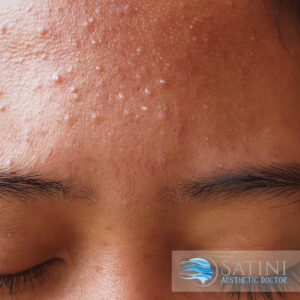
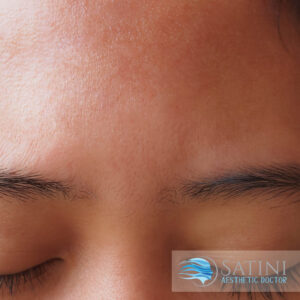
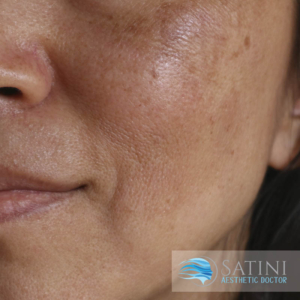
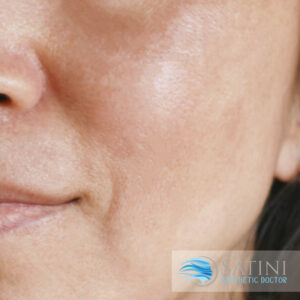
Peel For Uneven Pigmentation
A woman who was concerned about uneven pigmentation, dark spots and freckles. After several peels her skin was more even, radiant and lifted.

